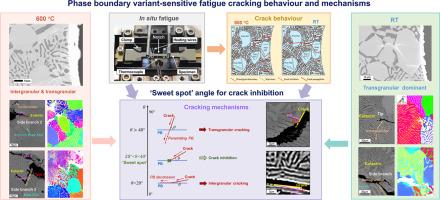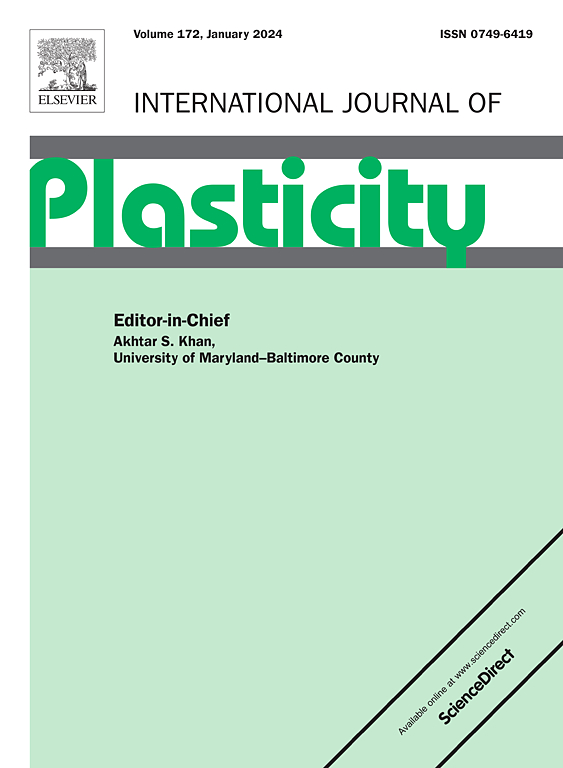高温下共晶高熵合金FCC/B2相界变敏疲劳开裂
IF 12.8
1区 材料科学
Q1 ENGINEERING, MECHANICAL
引用次数: 0
摘要
高熵合金(HEAs)以其优异的疲劳性能显示出高温结构应用的潜力。然而,在这些材料中,相界(PBs)作为特定的弱点来源可能会引发疲劳开裂。在这项工作中,使用原位和非原位方法研究了一个模型共晶HEA,重点是揭示FCC/B2 PBs的两种变体的作用- (i) B2/先前FCC之间的PBs(此处表示为i型PB)和(ii) B2/共晶FCC之间的PBs(表示为ii型PB)。我们的工作涉及两个基本问题。首先,这两种类型的PB是否在微观结构尺度上具有行为差异?第二,在什么条件下促进或阻碍疲劳开裂?我们的工作最终证明,PBs的两种变体确实受到PBs两侧不同硬度不匹配的影响而表现不同-正如我们的纳米压痕结果所证实的那样。此外,根据裂纹方向与共晶层状组织的定向形貌之间的角度不同,PBs在疲劳裂纹中表现出不同的促进和抑制作用。此外,某些显微组织取向表现出最大的抗疲劳开裂性。这些发现为通过微结构工程改进疲劳耐受性设计提供了新的见解,因为可以利用PBs的强化作用,并且可以优化共晶片层方向以获得最佳性能。本文章由计算机程序翻译,如有差异,请以英文原文为准。


FCC/B2 phase boundary variant-sensitive fatigue cracking in a eutectic high entropy alloy at high temperature
High-entropy alloys (HEAs) show the potential for high-temperature structural applications, with their superior fatigue properties of particular significance. However, fatigue cracking can be initiated in these materials with phase boundaries (PBs) as a specific source of weakness. In this work, a model eutectic HEA is studied using both in situ and ex situ methods with emphasis on unravelling the roles of two variants of FCC/B2 PBs – (i) PBs between B2/Prior FCC (denoted here as Type I PB) and (ii) PBs between B2/eutectic FCC (denoted as Type II PB). Our work addresses two fundamental questions. First, do these two types of PB confer differences in behaviour on the microstructural scale? And second, under what conditions is fatigue cracking promoted or hindered? Our work demonstrates conclusively that the two variants of PB do indeed behave differently being influenced by a varying hardness mismatch on either side of the PBs – as confirmed by our nanoindentation results. Moreover, the PBs demonstrate different roles in fatigue cracking, being capable of both promotion and inhibition, depending on the angle between the crack direction and the directional morphology of the eutectic lamellar structure. In addition, certain microstructural orientations demonstrate the greatest resistance to fatigue cracking. These findings provide new insights for improving fatigue-resistant design by microstructural engineering, because the strengthening effect of PBs can be leveraged, and the eutectic lamellar direction can be optimised.
求助全文
通过发布文献求助,成功后即可免费获取论文全文。
去求助
来源期刊

International Journal of Plasticity
工程技术-材料科学:综合
CiteScore
15.30
自引率
26.50%
发文量
256
审稿时长
46 days
期刊介绍:
International Journal of Plasticity aims to present original research encompassing all facets of plastic deformation, damage, and fracture behavior in both isotropic and anisotropic solids. This includes exploring the thermodynamics of plasticity and fracture, continuum theory, and macroscopic as well as microscopic phenomena.
Topics of interest span the plastic behavior of single crystals and polycrystalline metals, ceramics, rocks, soils, composites, nanocrystalline and microelectronics materials, shape memory alloys, ferroelectric ceramics, thin films, and polymers. Additionally, the journal covers plasticity aspects of failure and fracture mechanics. Contributions involving significant experimental, numerical, or theoretical advancements that enhance the understanding of the plastic behavior of solids are particularly valued. Papers addressing the modeling of finite nonlinear elastic deformation, bearing similarities to the modeling of plastic deformation, are also welcomed.
 求助内容:
求助内容: 应助结果提醒方式:
应助结果提醒方式:


